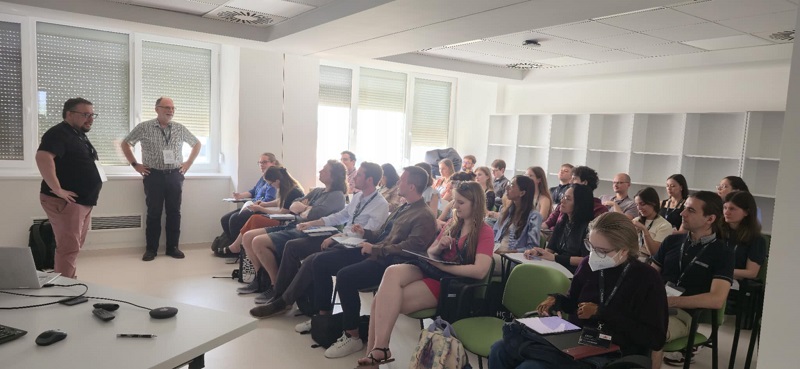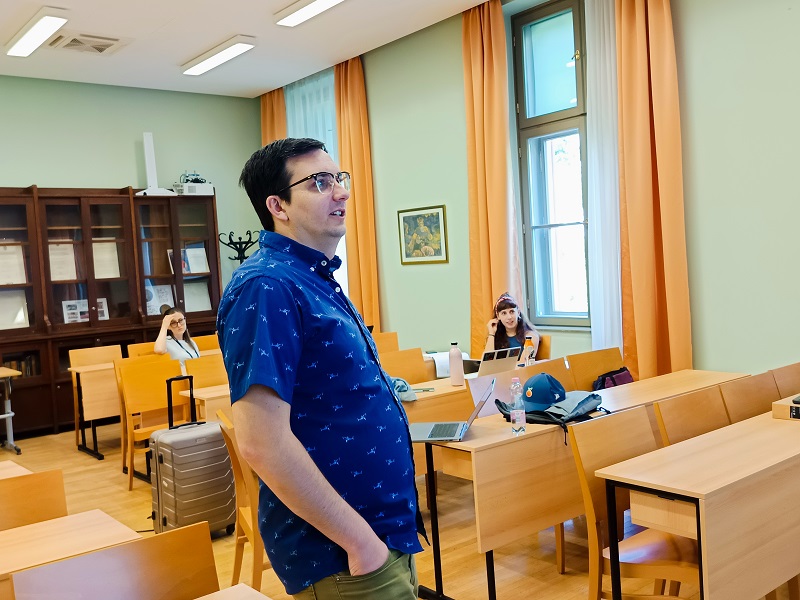
An international summer school focusing on the mathematical modelling of cancer was held at the University of Szeged, jointly organized by the Hungarian Centre of Excellence for Molecular Medicine (HCEMM) and the National Laboratory for Health Security. According to mathematician Dr. Gergely Röst, the laboratory’s scientific director, the aim was to offer young researchers in medicine and mathematics a gateway into a cutting-edge interdisciplinary field. Reflecting the shift in how mathematical tools are perceived in biomedical research, Professors Joel Brown and Jeffrey West – researchers from the Moffitt Cancer Center in Florida and guest lecturers at the summer school – stated that mathematical algorithms are becoming a form of medicine in their own right.
Modelling tasks rooted in real-world cancer research
Gergely Röst explained that the summer school was inspired by similar events organized by the Integrated Mathematical Oncology Department of the Moffitt Cancer Center in Tampa, Florida. Professors from the American institute, including Jeffrey West, were among the lecturers and workshop leaders at the event. They were joined by Professor Tommaso Lorenzi from the Polytechnic University of Turin and Professor Calum Gabbutt from Imperial College London. A total of 26 international PhD students were selected from 112 applicants to participate in the program. The students came to Szeged from research institutions in 16 countries, including top universities such as the University of Cambridge and Sorbonne University.

Mathematician Gergely Röst and mathematical oncologist Joel Brown at the summer school
“The idea was to ensure that the group of selected PhD students would be diverse – not only geographically or institutionally, but also in terms of professional background,” explained Gergely Röst. “The advantage of the summer school is that it brings together different scientific disciplines. This kind of cross-disciplinary expertise is essential in modern science, and the summer school gives students early experience in working within a multidisciplinary environment. That’s why everyone here came with a different background, and they had to learn how to collaborate and solve problems together. So, after the lectures delivered by renowned professors, the students were divided into teams and tasked with working on real-world problems. We intentionally formed the teams to include a mathematical modeler, a biomedical expert, and a data scientist – so that each person could contribute their own knowledge to the research challenge. The project assignments were provided partly by our international instructors and partly by HCEMM’s cancer research groups, and each task was directly connected to an active, real-life research project.”
In the field of cancer research, the Moffitt Cancer Center in the United States stands out as a pioneer in mathematical modelling. Joel Brown, professor of mathematical oncology at the institute, explained that Moffitt is the only institution in the world where an entire department within a cancer center is dedicated exclusively to mathematical oncology. “There are excellent mathematical oncologists around the world,” he said, “but here, in one place, nine faculty members and 30 to 40 postdocs, researchers, PhD students, and interns work together – directly alongside the clinical department.”
Knowing too much and too little at the same time
“Cancer is a highly dynamic condition – it evolves continuously, much like an epidemic: the infection spreads, people recover, gain immunity, lose it again, and new variants emerge,” he explained. “We observe similarly complex dynamics in cancer. It undergoes evolutionary changes, different cell types mutate, and healthy cell populations interact with malignant ones. We can track how cancer cells divide, how rapidly the tumor grows, what fuels that growth, and where the main intervention points might be – opportunities to halt or slow its progression. A tumor isn’t just a passive mass to be eliminated. Its cellular makeup is in constant flux. That’s what we aim to understand through mathematical methods. What’s especially critical is whether we can predict how the tumor will evolve – and how it will respond to treatment.”

Joel Brown, mathematical oncologist, conducts a hands-on modelling workshop at the summer school.
Joel Brown also explained why the epidemic modelling research conducted at the University of Szeged is a source of inspiration for him:
“The way therapies currently work is that we typically respond only once a problem becomes noticeable in the patient,” emphasized the American oncologist and mathematician. “But it’s possible to anticipate how a tumor will behave and develop a strategy accordingly. Of course, that requires a vast amount of clinical, microbiological, and genomic data – which is why the parallel with epidemic modelling is so exciting. Indeed, epidemiology, especially during the COVID pandemic, has taught us how challenging it is to deal with a developing, adapting organism. A similar challenge exists in oncology: we’ve known for decades that most cancer treatments fail because cancer cells eventually become resistant, yet this understanding has had little impact on how we treat cancer or what kinds of data we collect. Only recently have we begun to recognize that – just as with an epidemic – we must take the disease’s evolution seriously in order to design dynamic strategies, rather than rely on static, textbook-style approaches. In cancer care today, we simultaneously know too much and too little: once we shift our perspective, we realize that much of the information we’ve gathered is interesting, but not necessarily useful, while the data we truly need to guide treatment strategies remains incomplete.”
Mathematics as medicine
According to the American researcher, this modelling-based approach offers entirely new treatment strategies and is inherently built on the principles of personalized medicine.
“Personalized medicine is already a goal,” he noted, “yet current clinical practice still falls short of it. In treating cancer, we begin by measuring a wide range of tumor characteristics, and based on those, we select the protocol that seems most effective against that particular tumor. If the treatment works, it is continued – until it no longer does. The patient may initially respond well and show improvement, but eventually the disease can return. At that point, the physician switches to what’s known as a second-line therapy. But from then on, we’re no longer guiding the process – we’re chasing it. Now, this isn’t meant to be criticism – as the treatments we have are remarkable – but in the current form of personalized medicine, after the physician’s initial leadership, the cancer gradually takes over control, and we’re left trying to catch up. We’re no longer directing the course of the illness – we’re reacting to it. And this is where I’d draw another analogy to work done by the epidemic modelling team led by Gergely Röst: their work is also about getting ahead of viruses rather than simply responding to them. In the case of cancer, our goal is to show that personalized medicine should not only mean having a wide arsenal of drugs – it should mean applying individualized algorithms to design the treatment itself. The algorithm becomes the medicine. Then, after each treatment cycle, we assess the patient’s condition and determine where we stand in the chess game – are we gaining the advantage, or are we losing? And based on that, we adjust the therapy accordingly.”

Jeffrey West teaching at the international summer school on cancer modelling
Joel Brown also points out that mathematical models can only be as good as the data they are built on.
“If we take a blood sample from a patient with advanced cancer while the disease is in a rapidly changing phase, the data we obtain will be limited,” he explained. “Let me give you a concrete example: I have access to the data of a patient with advanced prostate cancer, whose physician I’ve been assisting in making treatment decisions. According to standard protocols, this patient should already have died. But because we monitor the disease weekly and adjust the treatment based on algorithms, he’s still alive. This stands in contrast to standard care, where PSA (prostate-specific antigen) levels are measured every three to six weeks. But cancer can do a lot in that time. It’s like checking on your house only once every six weeks – there could be a burst pipe, a power outage, or a broken refrigerator in between. But in our case, this patient is willing to provide data every week, and we believe that’s why he’s still alive. With regular measurements, we were able to fine-tune the model with such precision that it became personalized to him. So now, it’s not just the medication that’s tailored to his disease – he has a mathematical model designed specifically for his own cancer.”

Discussion on mathematical oncology – from left to right: Jeffrey West, Gergely Röst, Sándor Panek (the author of this article), and Joel Brown
Diverse approaches to tumor modelling
The American researchers also pointed out that the mathematical modelling of cancer can be built on a variety of strategies. “The truth lies at the intersection of three lies,” Joel Brown remarked with a smile. “I myself use ordinary differential equations for modelling,” he continued. “My colleague Jeffrey West, on the other hand, works with what’s known as agent-based modelling, where each cell is treated as an individual agent in space, with its own characteristics, interacting with others according to specific rules. It’s a different approach to modelling the same phenomenon. This diversity of methods was also reflected at the summer school, where there was an excellent lecture by Professor Tommaso Lorenzi, who uses partial differential equations to capture certain processes, while Professor Calum Gabbutt employs stochastic models to describe random mutations. In short, we have a wide range of modelling techniques at our disposal – allowing us to compare and validate results across different approaches.”
According to Jeffrey West, another highlight of the summer school was that it covered not only modelling methodologies but also the practical application of models. At Moffitt, a similarly structured training program focusing on cancer modelling is held annually in Florida.
“One of the PhD students in Szeged, Sadegh Marzban, completed his doctorate under the supervision of Gergely Röst on the topic of within-host viral dynamics, using a software tool developed at Moffitt,” said Jeffrey West. “The agent-based approach was later applied by the Szeged team to model the spread of chemotherapy-resistant cells, which even resulted in an artistic visualization that we featured on the cover of our mathematical oncology newsletter. I heard that a poster version of this visualization was also exhibited on the main pedestrian street during the University of Szeged’s centennial celebrations. Then, after completing his PhD, Sadegh joined my group at the Moffitt Cancer Center as a postdoctoral researcher –demonstrating just how closely viral dynamics and cancer research are connected. This collaboration has fostered a chain of partnerships, student mobility, and the sharing of best practices,” Professor West concluded.
The growing collaboration between Szeged and Moffitt is just one example of how mathematical oncology is gaining momentum as a global field. At the heart of this movement is a pioneering vision developed at the Moffitt Cancer Center in Tampa, Florida. The center’s mathematical modelling framework was initiated by radiologist Robert Gatenby and further advanced with the founding of the Department of Integrated Mathematical Oncology by mathematician Sandy Anderson in November 2008. More information about the institute is available at mathematical-oncology.org.
Original Hungarian article by Sándor Panek
Feature photo: Participants and lecturers at the international summer school on the mathematical modelling of cancer

